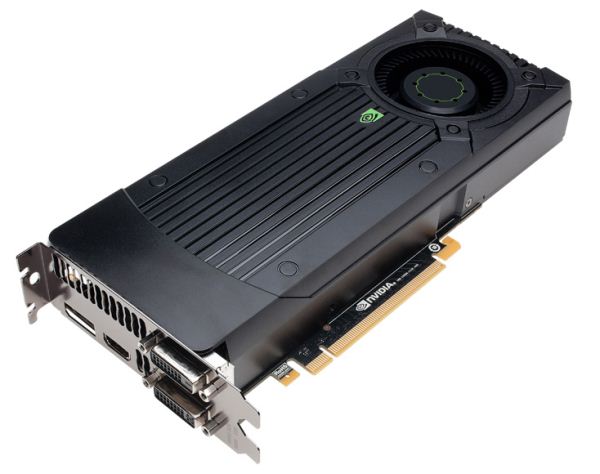NVIDIA Quietly Releases OEM GeForce GTX 660
by Ryan Smith on August 22, 2012 8:30 AM ESTAs is typically the case for NVIDIA when it comes to OEM products, they have once again quietly released their newest OEM video card. Their latest OEM addition is the GeForce GTX 660 OEM, which comes hot on the heels of last week’s launch of the retail GeForce GTX 660 Ti.
| GTX 680 | GTX 670 | GTX 660 Ti | GTX 660 OEM | |
| Stream Processors | 1536 | 1344 | 1344 | 1152 |
| Texture Units | 128 | 112 | 112 | 96 |
| ROPs | 32 | 32 | 24 | 24 |
| Core Clock | 1006MHz | 915MHz | 915MHz | 823MHz |
| Boost Clock | 1058MHz | 980MHz | 980MHz | 888MHz |
| Memory Clock | 6.008GHz GDDR5 | 6.008GHz GDDR5 | 6.008GHz GDDR5 | 5.8GHz GDDR5 |
| Memory Bus Width | 256-bit | 256-bit | 192-bit | 192-bit |
| VRAM | 2GB | 2GB | 2GB | 1.5/3GB |
| FP64 | 1/24 FP32 | 1/24 FP32 | 1/24 FP32 | 1/24 FP32 |
| TDP | 195W | 170W | 150W | 130W |
| Transistor Count | 3.5B | 3.5B | 3.5B | 3.5B |
| Manufacturing Process | TSMC 28nm | TSMC 28nm | TSMC 28nm | TSMC 28nm |
| Launch Price | $499 | $399 | $299 | N/A |
The GTX 660 OEM is another GK104 based video card, and like NVIDIA’s other OEM Kepler parts it’s a fairly conservative configuration. NVIDIA is shipping this card with only 6 of 8 SMXes enabled, the first time we’ve seen a desktop GK104 part with fewer than 7 SMXes. This further reduction in SMXes brings the GTX 660 down to 1152 CUDA Cores and 96 texture units, while on the raster side of things it’s unknown whether NVIDIA has disabled a whole GPC, or if they’re disabling SMXes in two separate GPCs. Meanwhile like the retail GTX 660 Ti this part has also had a ROP/L2/memory cluster disabled, giving it the same combination of 24 ROPs, 384KB of L2 cache, and a 192bit memory bus.
Looking at its specs NVIDIA seems to be particularly interested in getting a sub-150W Kepler card out – the GTX 660 OEM is rated for 130W and only requires 1 PCIe power connector – so compared to the other desktop GK104 parts the clockspeeds have also taken a hit. The GTX 660 OEM is clocked at just 823MHz core with an 888MHz boost clock, which is about 10% lower than the GTX 660 Ti. The memory clock is also a hair lower at 5.8GHz, an odd configuration since it means NVIDIA still has to equip the card with 6GHz GDDR5. At the same time NVIDIA is equipping the GTX 660 OEM with a fully symmetrical 1.5GB or 3GB of RAM, which coming from the asymmetrical 2GB GTX 660 Ti is probably a combination of cost-cutting and recognition of the fact that the OEM market isn’t quite as finicky about memory capacity as the retail market is.
Taken altogether, this puts the theoretical compute/rendering performance of the GTX 660 OEM at around 75% of the performance of the GTX 660 Ti, with the wildcard once again being the impact of memory bandwidth, which is almost unchanged. This is a larger step between cards than what we saw in the past generation of products (e.g. GTX 560 vs GTX 560 Ti), but at the same time NVIDIA’s OEM products are usually underspeced compared to their retail counterparts. For that same reason however we’d caution against looking too hard at the GTX 660 OEM for a sign of what the eventual retail GTX 660 will be like. NVIDIA’s been known to use different clockspeeds, different core configurations, and even different GPUs entirely, so everything is still on the table for now.
Source: Fudzilla











36 Comments
View All Comments
Dragonborn - Wednesday, August 22, 2012 - link
what does OEM mean ??euler007 - Wednesday, August 22, 2012 - link
Original Equipment ManufacturerRoland00Address - Wednesday, August 22, 2012 - link
what this means in english is you are going to see these cards in prebuilt HP, Dells, Alienwares, Gateways, Acers, Asus, etc but not on the normal market where you can buy the cards by themselves at newegg or best buy.tipoo - Wednesday, August 22, 2012 - link
System builders can use it, you can't.Unclean - Wednesday, August 22, 2012 - link
http://lmgtfy.com/?q=oemPatflute - Wednesday, August 22, 2012 - link
It better be $199. If it is I'll get it! (Retail version)maroon1 - Wednesday, August 22, 2012 - link
I think this should perform somewhere between HD7850 and HD7870If it cost $200 I would certainly buy it.
silverblue - Wednesday, August 22, 2012 - link
Depending on the title, that could be a small gap (Crysis: Warhead)... or a rather significant one (DiRT 3).CeriseCogburn - Thursday, August 23, 2012 - link
AMD has a crysis, they had better use their head to go to war, and that doesn't mean slinging pr dirt 3 times on the superior competitor nVidia.dmnwlv - Friday, August 24, 2012 - link
I cannot see where is the crisis and how is nvidia superior, especially when these 660 arrived half year late (AMD is already preparing for 8000 series)......are you just an nV fan? :)